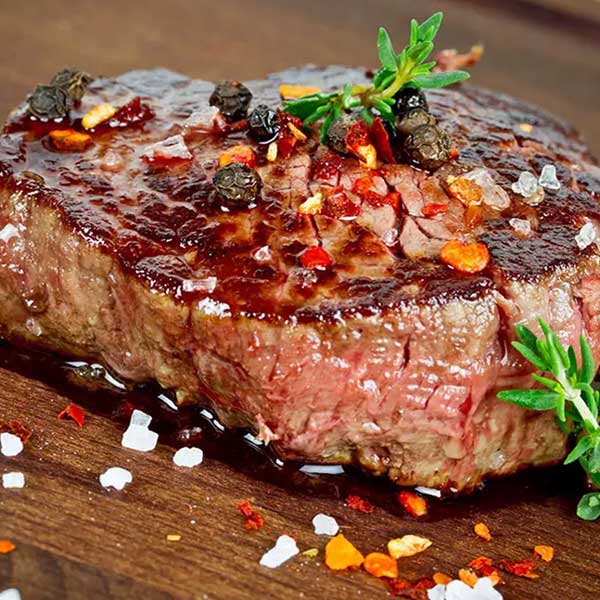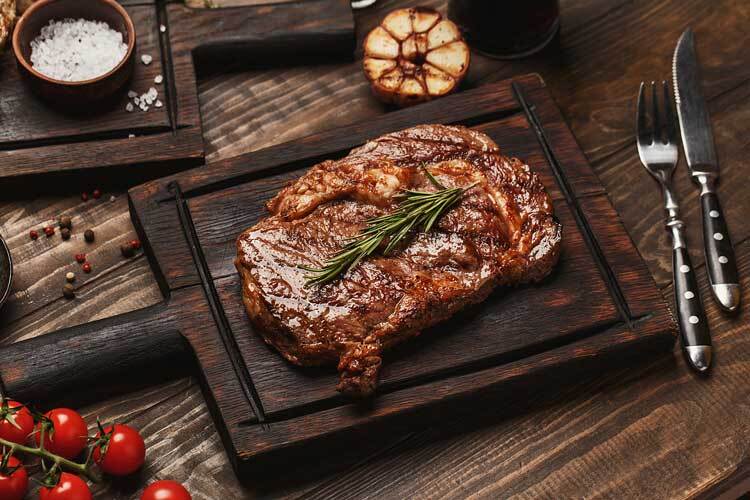The rich, beefy flavour of a perfectly grilled ribeye steak is a culinary delight that speaks to the soul of every grilling enthusiast. Ribeye steak has long been the prized cut for special occasions and backyard barbeques. Connoisseurs appreciate the tender texture, abundant marbling, and full-bodied taste that makes ribeye a cut above the rest. But not all ribeyes are equal, which is why discerning carnivores seek out the finest specimens sourced from ethically raised, grass-fed cattle. Only then can you experience ribeye at its most succulent and savoury best.
That’s why Ontario’s ribeyes stand apart as a cut worth savouring. With its rolling green pastures and small family farms, Ontario produces top-quality beef of exceptional quality. Their ribeyes from grass-fed cattle capture the essence of why this cut captivates steak lovers. Each mouthwatering bite bursts with rich, beefy flavour that satisfies on a primal level. Properly prepared, an Ontario ribeye is a perfect medium of velvety tenderness with just the right amount of fat marbling to enhance the taste. The result is a world-class steak experience befitting the centrepiece of a special meal. So, join us on a culinary journey as we explore the distinctive pleasures of Ontario’s finest ribeye steaks. Discover why they hit the sweet spot of flavour, texture, and nutrition to delight the most discerning carnivores.
Where Ontario Ribeyes Come From
Ontario is home to some of the finest ribeye steaks in Canada thanks to its lush grasslands and rich soil. The nutrient-dense grasses that the cattle graze on give Ontario ribeyes their signature robust, beefy flavour and tender texture.
Certain regions of Ontario like Grey, Bruce and Huron counties are particularly renowned for their prime ribeyes. Cattle farms nestled in these areas benefit from the ideal climate, rolling green pastures and proximity to fresh water that helps raise healthy, well-marbled steaks.
Ontario ribeyes come from cattle breeds like Angus, Hereford and Simmental that are specially selected for their naturally flavourful meat. The cattle roam freely outdoors on pasture and are 100% grass-fed their whole lives, resulting in ribeyes that have a deeper, more complex taste compared to corn-fed beef.
The open pastures give the cattle plenty of room to graze on clover, ryegrass and other greens that Ontario farms grow sustainably. This natural, stress-free environment and diet is what allows the beef to develop superior marbling while staying tender and juicy.
Nutritional Benefits
Ontario’s ribeye steaks provide exceptional nutritional value compared to conventional grain-fed beef. Grass-fed beef is higher in many vitamins, minerals and heart-healthy fats that are beneficial for human health.
Protein: Ribeye steaks are an excellent source of high-quality protein to support muscle growth and maintenance. A 6-ounce serving contains around 40 grams of protein.
Omega-3s and CLAs: Grass-fed cattle produce beef much higher in omega-3 fatty acids and conjugated linoleic acid (CLA) than grain-fed beef. Omega-3s and CLAs have been associated with reduced inflammation, improved heart health and faster fat loss.
Lower in total fat: Research shows ribeyes are lower in total fat than conventional ribeyes. They have a healthier fatty acid composition with more heart-healthy omega-3 fats.
Antioxidants: Grass-fed beef contains significantly higher levels of antioxidants like vitamin E and glutathione. These compounds help combat free radical damage and reduce oxidative stress.
Overall, Ontario ribeye steaks provide a nutritionally superior choice to support a healthy diet and lifestyle compared to regular feedlot-raised beef. Choosing grass-fed beef like Ontario ribeyes is a simple way to upgrade your nutrition.
Cooking Methods
When cooking an Ontario ribeye steak, there are several methods you can use to bring out the rich, beefy flavour of the cut. Three of the most popular cooking methods are grilling, pan searing, and broiling.
Grilling
Grilling is one of the best ways to cook a ribeye steak. The high heat of the grill sears the outside of the steak, creating a delicious, browned crust. At the same time, the inside cooks gently to your desired doneness. To grill a ribeye:
- Bring the steak to room temperature before putting it on the grill. This helps it cook evenly.
- Preheat your grill to high heat. Use a two-zone fire by leaving one side hotter for searing and one side cooler for cooking the steak through.
- Season the steak liberally with salt and pepper or a savoury herb rub.
- Place the steak over direct high heat. Grill for 2-3 minutes per side to get a good sear.
- Move the steak to indirect heat and close the grill lid. Cook to your desired internal temperature. For medium-rare, remove it from the grill at 135°F and allow to rest.
- Let the steak rest for 5-10 minutes before slicing. This allows the juices to redistribute.
Pan Searing
Pan searing on the stovetop is a quick and easy way to cook ribeyes with excellent browning. To pan sear:
- Pat the steak dry and season all over with salt and pepper. You can also use an herb rub or marinade.
- Heat a cast iron or stainless-steel skillet over high heat until very hot. Add a small amount of high smoke point oil like avocado or grapeseed oil.
- Place the steak in the pan and let sear undisturbed for 2-3 minutes to get a good crust.
- Flip and sear the other side for another 2-3 minutes.
- Turn heat to medium and cook to desired doneness, flipping occasionally. Use a meat thermometer to check internal temp.
- Remove from pan and let rest 5-10 minutes before slicing against the grain.
Broiling
Broiling uses high heat from above to quickly cook and brown the ribs. To broil:
- Preheat broiler to high. Place oven rack 6 inches from heating element.
- Season steak all over with salt, pepper, herbs or other seasoning.
- Place steak on a broiler pan or baking sheet. Broil for 2-3 minutes per side until browned.
- Flip and move to centre of oven if needed. Cook until desired internal temperature.
- Remove from oven, tent loosely with foil, and allow to rest 5-10 minutes before slicing and serving.
No matter which cooking method you choose, the key is properly searing the outside of the steak to develop a flavourful crust while cooking the interior to your desired doneness. Resting before slicing will result in a juicier, more tender ribeye.
Sides and Pairings
Ribeye steaks are typically the star of the show but pairing them with complementary side dishes and beverages can take the meal to the next level. Here are some tasty options:
Complementary Vegetables and Starches
Baked or mashed potatoes – Ribeyes pair wonderfully with creamy, buttery potatoes. Yukon gold or russet potatoes work well baked, roasted, or mashed. Add herbs, garlic, or cheese for extra flavour.
Asparagus – The crisp snap of fresh asparagus balances the rich beefiness of the ribeye. Grill or roast spears until tender-crisp.
Creamed spinach – Ribeyes love a green veggie side. Wilted spinach gets a luscious creaminess from a sauce of butter, onion, and heavy cream.
Brussels sprouts – Roasted Brussels sprouts caramelise beautifully. Toss halved sprouts with olive oil, salt, and pepper and roast in a hot oven until browned and tender.
Wild rice pilaf – Nutty wild rice makes a hearty side for ribeyes. Cook rice pilaf-style with chicken or vegetable broth and season with herbs.
Wine and Beer Pairings
Cabernet Sauvignon- This full-bodied red wine has enough structure and flavour to stand up to a ribeye steak. Cabernet offers notes of black currant, cedar, and dark chocolate.
Malbec – An Argentinian Malbec delivers robust fruit flavours like plum and blackberry along with smoky, peppery spice. It’s a perfect complement to seasoned ribeye.
Porter or stout beer – The roasted maltiness of porters and stouts pairs deliciously with grilled, savoury ribeyes. Try local Ontario craft beers.
Zinfandel – Rich, jammy Zinfandels from California have ripe berry flavours and black pepper spice that brings out the best in ribeye steaks.
Building a Complete Meal
Ribeyes deserve an entire meal built around them. From appetisers to desserts, create a cohesive dining experience:
- Start with a fresh salad of baby greens, tomato, and Parmesan.
- Offer warm bread with compound butter.
- For dessert, ribs prefer something chocolatey like molten lava cake.
- Share family-style sides like scalloped potatoes and sauteed mushrooms in addition to personalised servings of vegetables.
- Offer both wine and beer so guests can choose their beverage pairing.
With thoughtful sides, drinks, and starters and finishers, you can design a complete Ontario ribeye steak dinner.
Ontario Ribeye Recipes
The rich, beefy flavour of Ontario ribeye makes it the perfect star ingredient for appetisers, entrees, and even desserts. Consider these delicious recipe ideas:
Ribeye Carpaccio Appetizer
Thinly slice a ribeye against the grain, drizzle with olive oil, lemon juice, and freshly grated Parmesan. Top with arugula and serve with grilled bread slices. The tender ribeye makes for a melt-in-your-mouth carpaccio.
Coffee-Crusted Ribeye with Balsamic Glaze
Coat ribeyes with a rub of coffee, brown sugar, chili powder, salt, and pepper before grilling or pan-searing. Make a glaze from balsamic vinegar, maple syrup, and brown sugar to drizzle over the steaks before serving. The bittersweet glaze complements the rich coffee-encrusted beef.
Ribeye Steak Fajitas
Sear ribeye slices until medium rare. Slice into strips and toss in a hot skillet with sautéed peppers and onions. Wrap in warm tortillas and top with fresh pico de gallo, guacamole, cilantro, and a squeeze of lime. A quick and easy Tex-Mex meal.
Chocolate Ribeye Protein Bars
Blend oats, dark chocolate chips, peanut butter, ground flaxseed, and egg whites. Stir in chopped ribeye until fully combined. Press into a loaf pan and refrigerate until firm. Cut into bars for a high protein snack with a beefy twist. Savoury, sweet, and satisfying.
Grilling Tips
Grilling a perfect ribeye steak requires paying attention to a few key techniques. Proper grill preparation is essential – make sure the grates are thoroughly cleaned and oiled before cooking. Preheat the grill completely to ensure even cooking. Use direct high heat (about 550-600°F) to get those lovely grill marks and caramelisation on the meat. Avoid constant flipping to get those quintessential criss-cross grill marks.
For added flavour, try using indirect heat and smoking. Set up a two zone fire – pile coals or heat on one side, leaving the other with no coals directly under. Place the steaks on the no-direct-heat side and add hardwood chips or chunks to generate smoke. Cover the grill to capture the smoke. The steaks will gently cook from the ambient heat while absorbing delicious smoky flavour. Apple, hickory, oak, and mesquite are all excellent wood choices.
Monitor the internal temperature to take the steaks off at the desired doneness, around 125-135°F for medium rare. Let rest for 5-10 minutes before slicing and serving for juicy, tender ribeyes with the perfect char and smoky essence. Proper grilling technique allows the exceptional flavour of Ontario’s ribeyes to shine.
Food Safety with Ribeye Steaks
Properly handling and cooking ribeye steak is important to avoid foodborne illness. Here are some tips:
Proper Storage and Thawing
- Store ribeye steaks in their vacuum packs in the coldest part of the refrigerator at 40°F or below. Use within 3-5 days.
- For freezer storage up to 12 months, Farmway Foods packages the steaks accordingly and guarantees and provides guarantee against freezer burn.
- Thaw frozen ribeyes in the refrigerator, not on the counter. This slow thawing helps prevent bacterial growth. Place on a plate to catch any drips as it thaws over 24 hours.
Cook Thoroughly and Monitor Temperature
- Ribeyes should be cooked to an internal temperature of at least 145°F as measured by a food thermometer. This kills any harmful bacteria.
- Use a digital instant-read thermometer to check temperature in the thickest part of the steak.
Avoid Cross-Contamination
- Prevent raw meat juices from dripping on other foods by keeping them separate. Use different cutting boards and utensils for raw and cooked foods.
- Wash hands, cutting boards, counters, and utensils with hot soapy water after handling raw steaks.
Following proper food safety measures will help ensure ribeye steaks are safe to enjoy. Cook thoroughly, use a food thermometer, and prevent cross-contamination.
This culinary journey with Ontario’s finest ribeye steaks has highlighted the exceptional flavour and quality that makes them stand out. From learning about the local farms where these premium cuts originate, to discovering cooking tips and recipe ideas, it’s clear why Ontario ribeyes are savoured by top chefs and backyard grill master’s alike.
Their superior marbling and robust beefy flavour deliver a tender and juicy steak experience. The nutritional benefits of grass-fed beef also make Ontario ribeyes a smart choice. We’ve covered a range of cooking methods from grilling, broiling, pan-searing and more to bring out the very best in these steaks. Pairing recommendations provide guidance to complement and enhance their flavours.
As we conclude this culinary tour, be sure to seek out Ontario ribeyes at Farmway Foods. Try some of the mouthwatering recipes included here. Most importantly, take a moment to savour the exceptional flavour of each bite the next time you enjoy these premium steaks. Ontario ribeyes represent the pinnacle of quality and taste – a proud culinary tradition well worth celebrating.







